Guest blogging can be a game-changer for startups and growing businesses looking to win earned media coverage from PR activity. Also known as guest posting, it allows you to build your legitimacy and credibility within the eyes of your target audience. And the more guest posting you do, the more authority you’ll have within your industry.
Then, there’s the SEO benefit from all those backlinks you can earn from guest blogging. This makes it the ultimate PR and SEO win-win.
Pretty good, huh?
That’s why we’ve written this guide to guest blogging, which will teach you everything you need to know, including:
- The benefits of guest posting
- How to find guest blogging opportunities
- How to pitch a guest post
- How to write a guest post article
- SEO and guest blogging best practices
- How to build on guest posting successes

A guest blog, post, or article refers to a piece of content that you write, which is then published under your own name on a third-party media organization’s website.
Guest article writing on a legitimate website shouldn’t cost you anything (apart from your time pitching and writing it). This is different to native advertising/sponsored content, which is also published under your own name on third party publications, but which you have to pay for.
So why does guest posting have no direct cost, whereas native advertising you have to pay for?
Well – this brings me nicely onto the purpose of guest posting. Media outlets will publish these types of articles free of charge as the purpose is to provide expert insight and analysis to their readership. For example, a CEO providing insight on the future of his or her industry, or a professional offering key technological trends which are affecting their industry.
Guest posts, therefore, ARE NOT a self-promotional sales exercise. I cannot stress this enough – and I will continue to beat this like a dead horse throughout this guide.
This is in contrast to native advertising, which is an outwardly self-promotional piece of marketing. While these are presented alongside regular articles (hence the term “native”), they’re clearly marked as “sponsored content”, so readers know these are advertisements.
PRO TIP: If a website asks for money to publish a guest post, be wary of this. A legitimate media outlet will not expect payment. Also – paying for guest posts which contain follow backlinks goes against Google’s link scheme guidance. More information on guest blogging and SEO is provided below.
Benefits of guest blogging
You may be thinking… “If they aren’t going to promote or sell my product or service. What’s the benefit of guest blogging?!’
Well, although they shouldn’t be self-promotional, there are still many benefits to incorporating these into your marketing strategy:
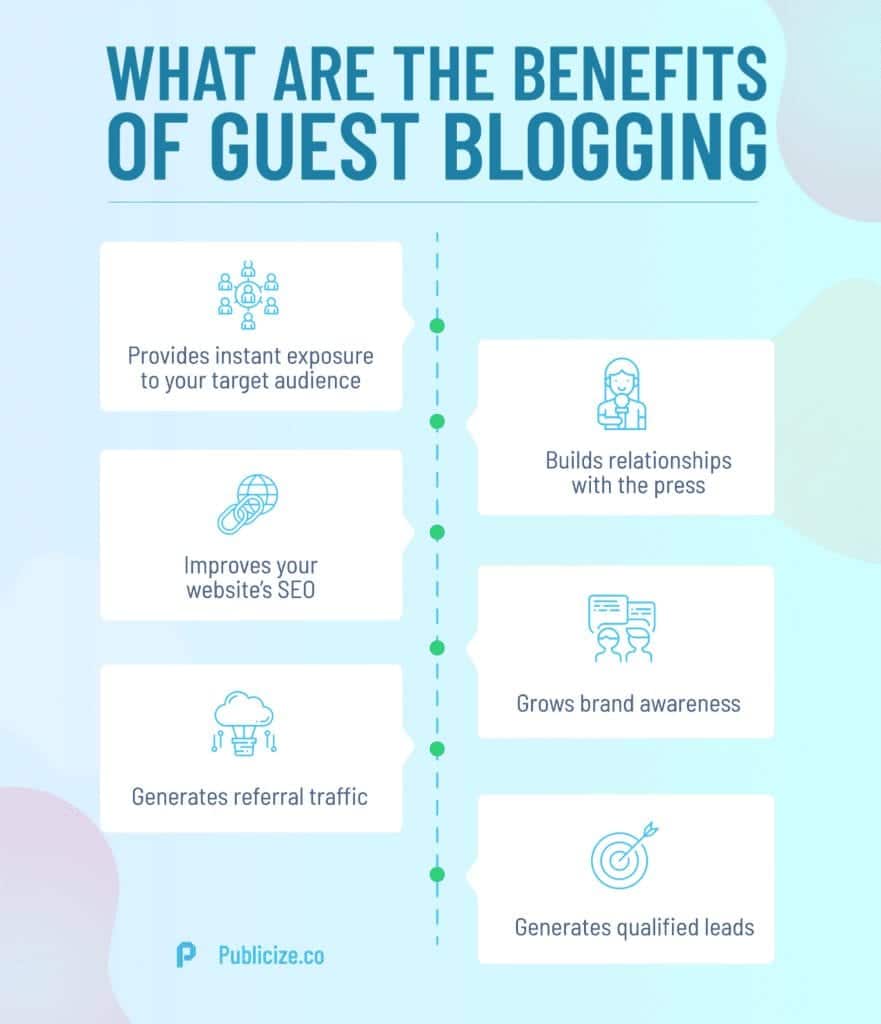
1. Provides instant exposure to your target audience – Guest posting in industry-specific publications allows you to reach more people and get in front of your target audience.
2. Builds relationships with the press – If your guest post ends up being a success, that publication becomes a useful contact for future press coverage opportunities.
3. Improves your website’s SEO – Getting guest posts published on high authority sites with backlinks to your site is a big SEO win. The more high quality backlinks your site has, the more authority your site will have, and the more you’ll move up Google’s search rankings.
4. Grows brand awareness – This is pretty self-explanatory. The more places your business is featured or mentioned; the more your brand will be recognized.
5. Generates referral traffic – As guests’ blogs will usually contain a backlink to your website, they’re also great for generating referral traffic from users clicking through to your site.
6. Generates qualified leads – As guest blogs generate referral traffic, you can channel these users into a lead capture process. For example, you could link readers back to a high-value piece of content on your site – the full version of which is available through an email sign up. Then, hey presto, you’ve converted them into a lead.
7. Helps to establish yourself as a thought-leader – Through guest posting on industry-specific sites, you’ll begin to establish yourself as a thought leader in the eyes of your target audience. This will help to further increase your authority and credibility.
While it may seem that the internet throws up a plethora of blogs that accept guest posts, you need to approach this with clear goals and objectives. After all, not all guest blogging sites are equal!
Therefore, it’s good practice to have a plan of action for researching, creating and pitching your guest articles to the media.
But fear not, we’ve got you.

Without further ado, here’s our guide to guest blogging:
Guest post goals
First things first, you’ll want to determine what’s the end goal of your guest blogging strategy.
Here are a few general objectives you should be aiming for:
1. To position yourself as an industry authority
2. To grow your exposure with your target market
3. To earn backlinks to your website
That being said, valuable, well-crafted content should cover all three. And this is what you should be aiming for.
What to consider
There’s one question you should always ask yourself when choosing where you want to pitch and, eventually, get your guest articles published:
Is this website relevant to my target audience?
After all, the purpose of all PR activity is to reach your target audience through earned media and build a specific narrative.
A way to look at this is to split target media outlets by “top tier” and “industry specific” outlets, as the infographic below shows.
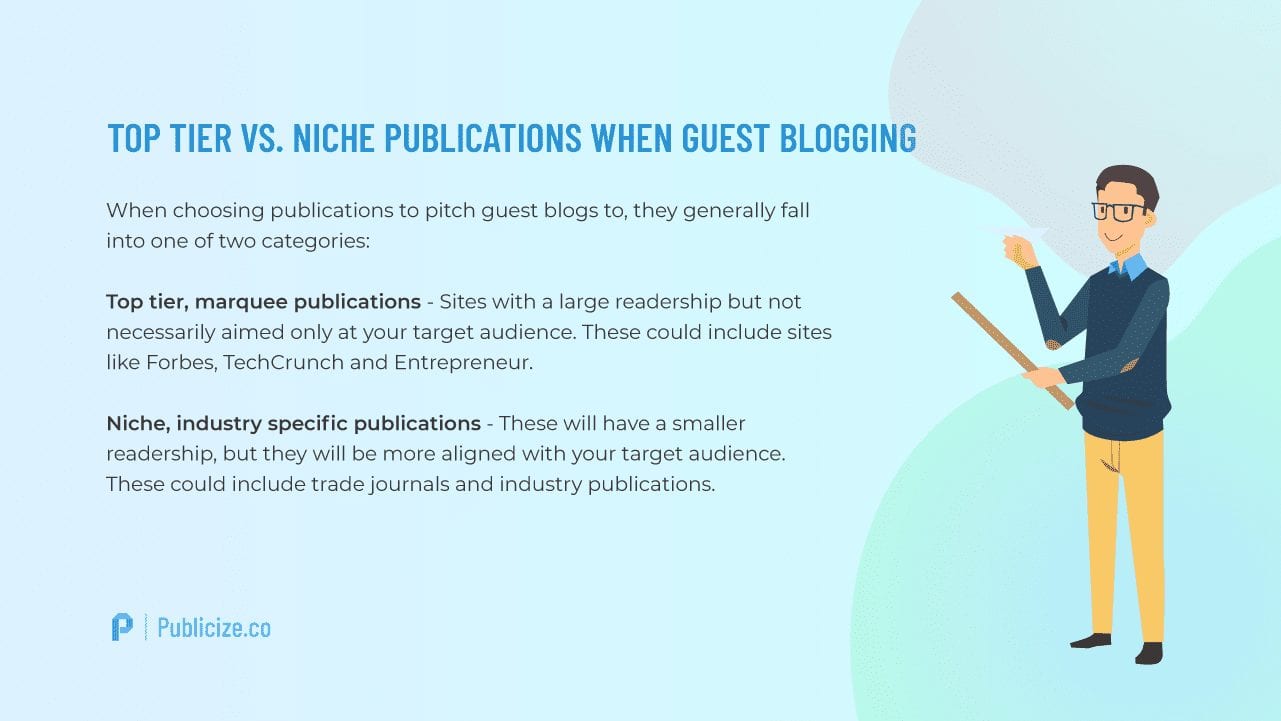
In addition to which kind of publication you target, here are a couple of other things to consider:
- Do they have an engaged readership who actively share posts on social media? – Buzzsumo is a great tool to use to measure social engagements and other website metrics. This is important, as an engaged audience is more likely to share your guest posts, which will increase your exposure.
- The DA score of the site – When it comes to guest posting for SEO, you want to be targeting publications with high domain authority (DA) scores. The higher the authority a website has, the more valuable a backlink from that site is. As a rule of thumb, aim for sites with a DA score of at least 45. You can check this easily by using the free Moz Toolbar.
If you’re looking for a candidate with a very-high authority, you would be looking at websites with a DA score of over 90.

In this example, you can see that Forbes has a DA score of 95. Therefore, they would be a very good, ‘top tier’ candidate.
However, your objective is to build awareness of your presence within your own target market, you need to consider whether your target audience read this publication. If not, it might be worth targeting niche, industry-specific publications.
How to find guest blogging opportunities
Now you’ve considered why and where you’d like to submit your guest blog post- you need to find where there are opportunities to do so:
Here are a couple of ways to get the ball rolling:
Google searches – Google is the best place to start with this. This simple keyword exercise will help you get the ball rolling. All you need to do is replace the keyword below with a keyword within your industry and let the search begin!
- keyword “submit a guest post”
- keyword “guest post”
- keyword “guest post by”
- keyword “accepting guest posts”
- keyword “guest post guidelines
For the following example, let’s imagine you’re a logistics company that uses blockchain technology. You could start off with a broad keyword like ‘blockchain’ “submit a guest post”:
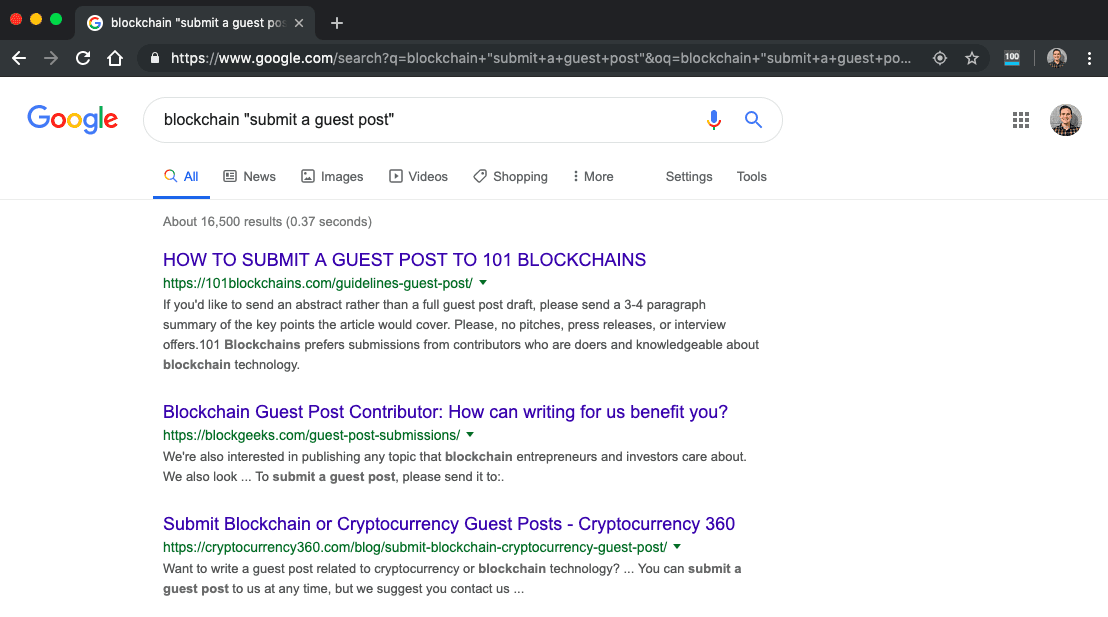
The top three websites ALL accept guest posts. In addition, we know they are relevant to our guest blogging goals because they rank on the first page for an industry-specific keyword.
Use your own knowledge – It’s likely that you’ll have a vague knowledge of some publications that are prevalent in your industry, too. Go on their websites and take a look at the guest post submission guidelines.
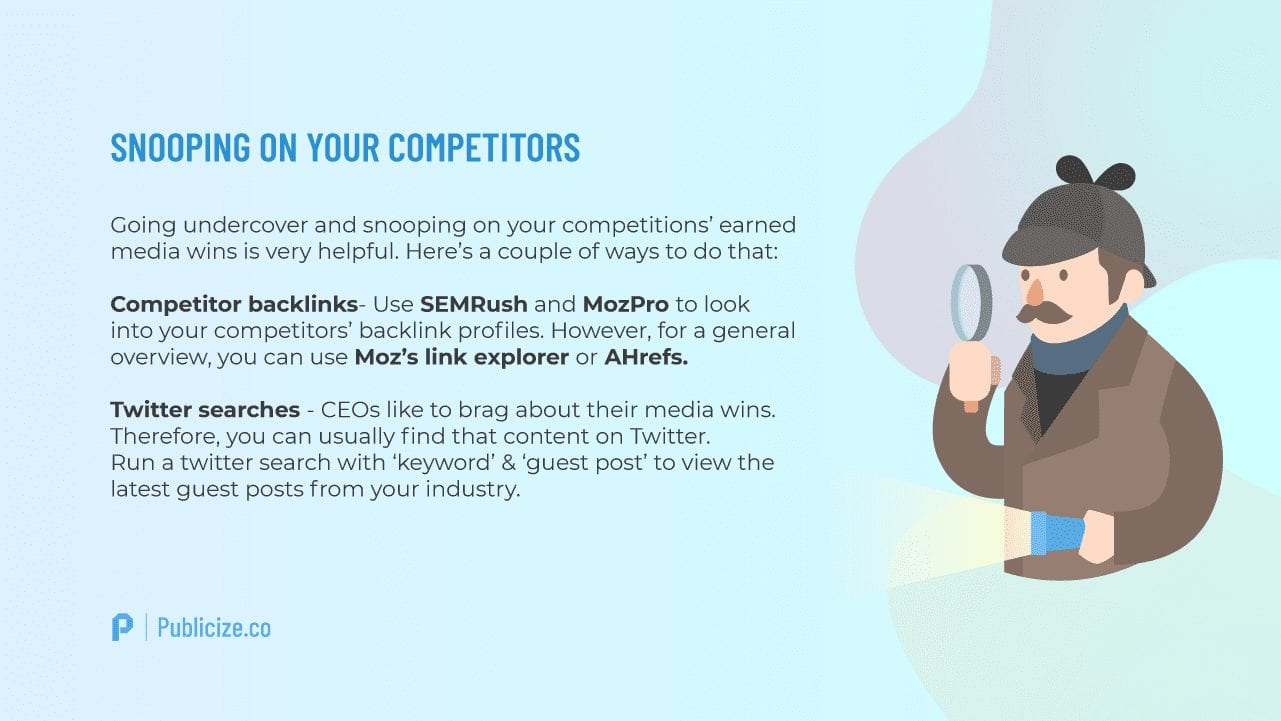
Pre-pitching your guest post
So you’ve done your keyword research, snooped on your competitors’ backlinks, and decided on the publications that best meet your objectives. Now it’s time to get prepped to pitch. Here are some ways you can do just that:
Get to know the publication’s content
This is vital information to gather before you pitch. Yes you’ll have an idea on what you’d like to write about, but this isn’t necessarily going to benefit or interest the publication you’re pitching too.
Therefore, you want to get a feel for their content.
You should consider:
1. Who is their audience?
2. What’s their audience’s level of understanding?
3. What type of content do they publish?
4. What type of guest posts have they published in the past?
Read the publication’s guest post guidelines
No two publications are the same. One article may be acceptable to one publication but not accepted elsewhere. Therefore, it’s important to check the publication’s guidelines when coming up with a pitch idea.
If you can’t find them on the site, then just Google the website’s name followed by “guest post guidelines” or hunt around in the sitemap.
The guidelines will often state the topics that the publication is interested in as well as the format the pitch should be in. Therefore, it’s vital you read these first.
We’ve attached Entrepreneur’s contributor writing guidelines here:

By Entrepreneur’s own admission, guideline pages are usually lengthy. Hence the ‘TL;DR version’. However, you should always read them in their entirety.
Entrepreneur’s main requirements for guest article writing are:
- You have unique and original ideas
- You back up your arguments and link to your sources
- You don’t plagiarize
- You’re not accepting payment for mentioning a person or business
These requirements will be different for every publication so make sure you read all of them.
What value can you add
After you’ve analyzed the content on the publication’s website, you can begin to ponder:
What can I offer?
For instance, is there a new perspective you can give on a frequently covered subject. On the other hand, is there something that hasn’t been covered but is in the same ballpark as their existing content?
Remember: publications are frequently contacted with offers of ‘exclusive content’. You want to make sure yours stands out above the rest. Therefore, considering the value you can add before pitching is very important.
Find out which posts do the best
Using Buzzsumo you can easily check which articles generate the most engagement on any website. This provides valuable insight when it comes to honing in on popular topics.
The more popular or current your guest blog topic is about, the higher the chances your content will be read by the publication’s readership.

How to pitch a guest post
Build a rapport with the press
OK, this is something vital to consider when you’re writing out your pitch: you need to build a relationship with the journalist or editor in question.
This is just as important, if not more important, as the quality of your writing. Journalists hate blind pitches and they want to work with people who have something to offer them.
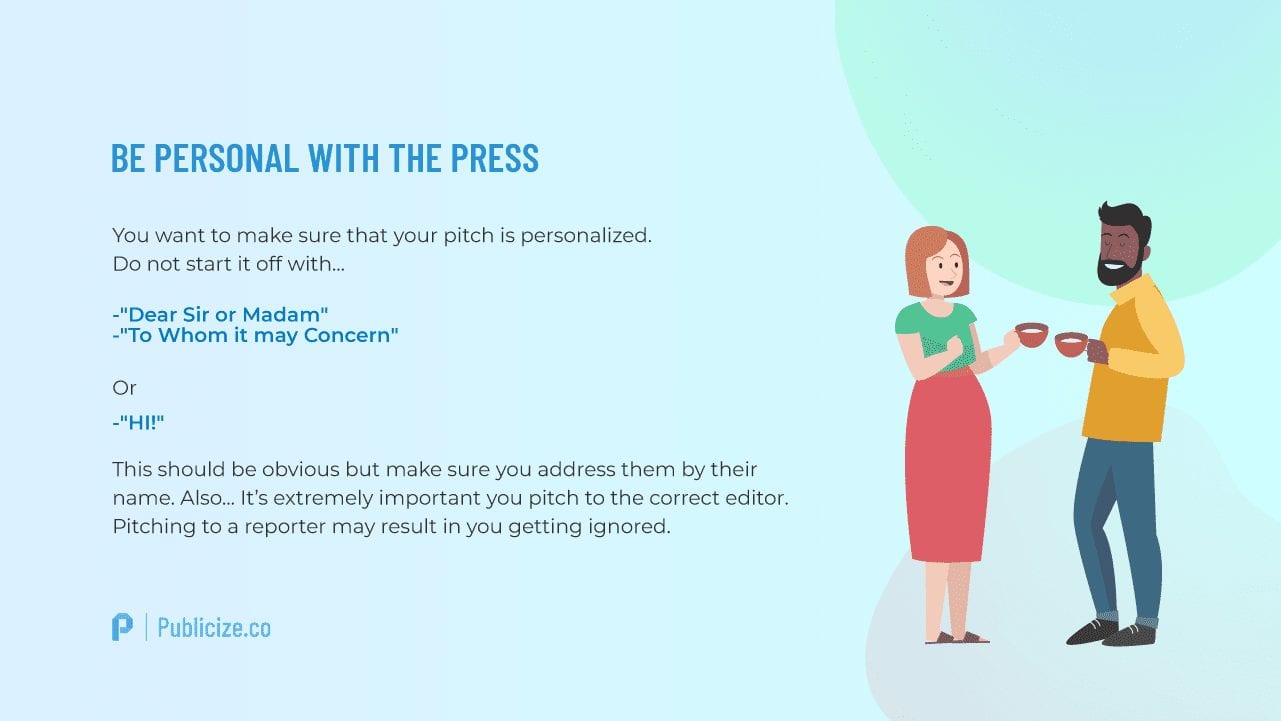
Sell up your credentials and expertise
Why should they let YOU guest post on their publication?
Why does your professional background qualify you to write about this subject?
This is where you need to flex your metaphorical muscles and show off your social proof.
What is social proof?
Social proof, in a public relations sense, is all about credibility. When it comes to pitching a guest post, this is the way in which you demonstrate your authority on the subject. Interestingly enough, guest posting is a great way to build your social proof but there are many other ways too.
So always be sure to outline:
1. Why you’re choosing to write about the subject you’ve chosen.
2. Why you’re qualified to write about it
Use the pitch to show your writing abilities
This should be common sense but make sure your pitch is as well written as possible.
No one will take your pitch seriously if it’s poorly written.
In addition to this, if you’re relatively new to pitching and don’t have many examples of previous guest posts, it may be worth including a truncated version of the planned article in the pitch.
And remember to take time when you’re pitching to journalists, this is the deciding factor as to whether or not you’ll get accepted.
Here’s a successful guest post pitch we made on behalf of one of our clients:

You can also read our blog on guest post pitching for a more detailed walkthrough of this process.

How to write and submit a guest post
Here are some things to keep in mind when writing and submitting a guest blog or post:
Don’t make it too self-promotional
Editors will disregard pitches they consider to be self-promotional. And they can see it coming a mile off.
Guest articles should stand up as valuable sources of information for a website’s readership, not an advertisement for your business.
Occasional mentions, stories and examples are OK, but do not go overboard. Don’t blow your own trumpet and try to keep any info regarding yourself in the writer’s bio.
Include internal and source links
It’s also worth including some internal links to other articles in the publication.
This shows you’ve done your research and have written content that their audience will be interested in.
Format in a similar way
Does the site use…
-Headers
-Bolded text
-A lot of images
-Quotes
-Any other special formatting
Make sure you stick to the style guide and get a feel for their writing style. The guest posting guidelines should provide all the information you need to know about this.
Including subsections to organize your article
Formatting in a style similar to the website you’re writing for is important.
However, so is including subsections and subheadings throughout your content. It’s fair to take it as red that the publication you’re pitching to will prefer it this way too.
This will not only benefit you when organizing and collaborating with all your themes and ideas, but it will also make your articles easier for readers to use, increasing the likelihood of them staying on the page.

Guest blogging and SEO: what are the best practices?
Guest blogging and SEO are very closely related. The reason for this is that many sites that accept guest posting will also include a backlink to the website of the person who wrote it.
And why is this important?
Because backlinks are still one of the most important ranking factors when it comes to SEO.
They pass “link equity” from the site that’s giving the backlink to the site receiving the backlink. Furthermore, the more quality backlinks a site receives, the more authoritative it becomes. This results in it shooting up Google’s ranking.
So when it comes to publishing guest posts and earning backlinks, there are two places where these can go, as this infographic shows.
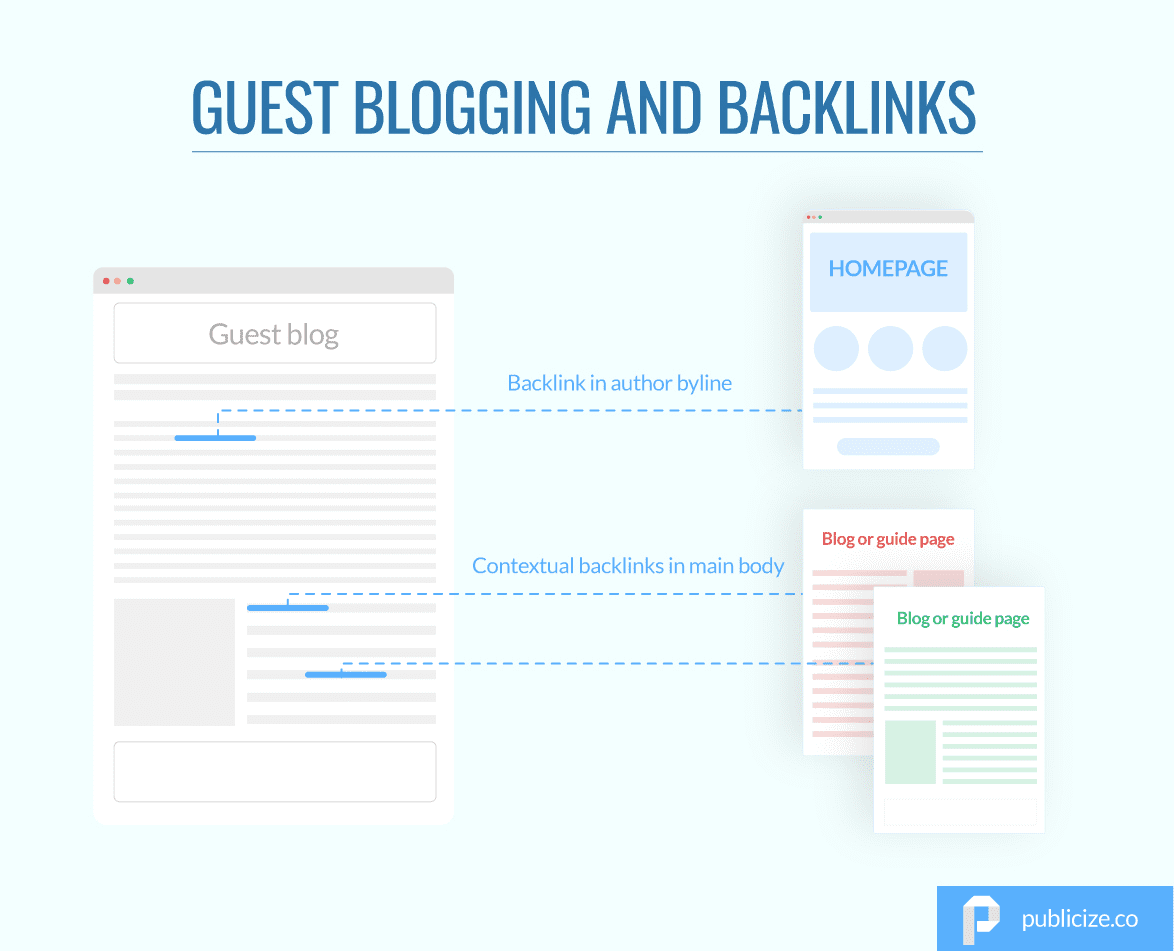
In which case, if you want to use guest posting to improve your website’s SEO (in addition to the PR benefits already discussed), there are a few factors you have to consider:
Do author bylines include a backlink
Author bylines are usually at the top or bottom of the article. It’ll have the author’s name and a sentence explaining who they are. It’s here where a backlink is usually included to the person’s website. Or there may be an internal link to the author bio page here, and you’ll then find the backlink on the author bio page.
Nofollow versus follow links
There are two types of backlinks, follow and nofollow. A nofollow backlink instructs Google not to crawl the link, which means no ‘link equity’ is passed to the website receiving the link. This means you receive no SEO benefit. Therefore, you need to check if a website’s recent guest posts have follow or nofollow backlinks before you pitch to them
How can you check whether links are follow or nofollow? ‘Follow’ these steps:
1. Go onto the publication’s website using Google Chrome, then go into Developer Tools:
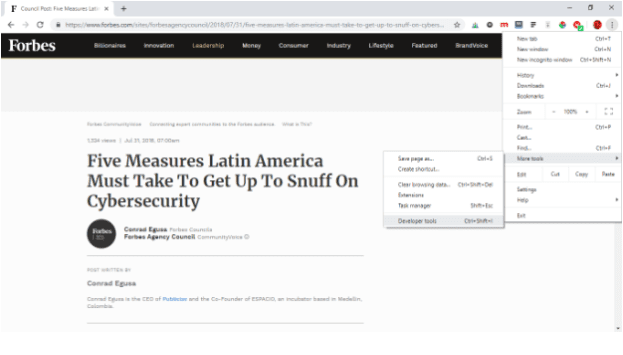
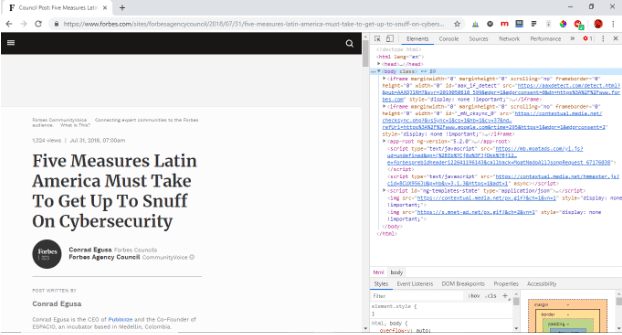
2. Now press “CTRL+F” and a search bar will appear beneath the text box containing the HTML code. Type in “nofollow” here:

3. Press the up and down arrows on the side of the search bar, to view all nofollow links on the page. This is displayed like this, with the backlink highlighted on the left hand side and the HTML code shown on the right hand. (Note – A follow link does not have the word “follow” in the HTML, as all links are follow by default, which is why “nofollow” is added to the code for all nofollow backlinks)
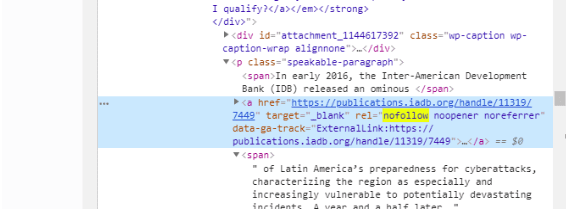
4. Check to see if both the backlink in the author byline and the backlinks within the main body of the guest post are follow or nofollow. Some websites will have a follow backlink in the author’s byline, but will set all backlinks in the body to nofollow, or vice versa. You’ll get the most SEO value from sites with follow backlinks in both places, but you’ll still get value if there’s a follow backlink in one of these places.
Inserting backlinks to your website into the main body of a guest post
When it comes to inserting backlinks to your website into the main body of a guest post (known as contextual backlinks), there are a few things you have to bear in mind.
Firstly, make sure these backlinks are editorially relevant.
What do we mean by that?
Editorially relevant means that the content that’s being linked to provides further reading on the topic or a related topic that’s being discussed in the guest blog. For example, providing a link to a blog post on your site that explores a topic in more detail.

Secondly, don’t overdo it! Don’t link to the same page twice, and only put a maximum of two backlinks to your website into the main body of a guest post. Any more and this will look spammy which editors don’t look too kindly upon
And lastly, be aware that some websites may have specific rules about inserting contextual backlinks. Therefore, always read their guest post guidelines before doing this.
How to build on guest posting successes
You’re no longer asking ‘how to start guest blogging?’ – you’re now a fully fledged contributor writer. Well done you!
However, it’s not quite time to start patting yourself on the back. It’s now time for your guard of honor. The aftermath is an important part of any guest blogging strategy.
So, what can do you do?
Share on your own channels
This is good practice for any time you post something in-house or on another site. Being social is important! So, be sure to share your earned media wins earned media on all of your owned channels (your blog, your website, and your social media) and include links to your own website.
Side note: be sure to tag the publication when you’re sharing it, this furthers your relationship with them and can help lock down future earned media opportunities with them.
Share via your newsletter
While one of your main aims may be to reach new audiences with guest submissions, don’t forget to let your existing community know about your success too! Sharing your media wins via your newsletter, or via a short marketing email is a great way to share your content with your current customers, and community too.
Conclusion
By following the advice in this guide on how to start guest blogging, you’ll be sure to increase your chances of winning guest post spots in publications relevant to your industry.
Guest blogging remains a proven way of getting exposure for your brand, earning valuable backlinks and improving your website’s SEO, and building up authority within your industry.
Yes, there is a bit more work involved when compared to posting on your own site. However, as I hope this guide has demonstrated, the benefits of a successful guest blogging strategy are huge.





